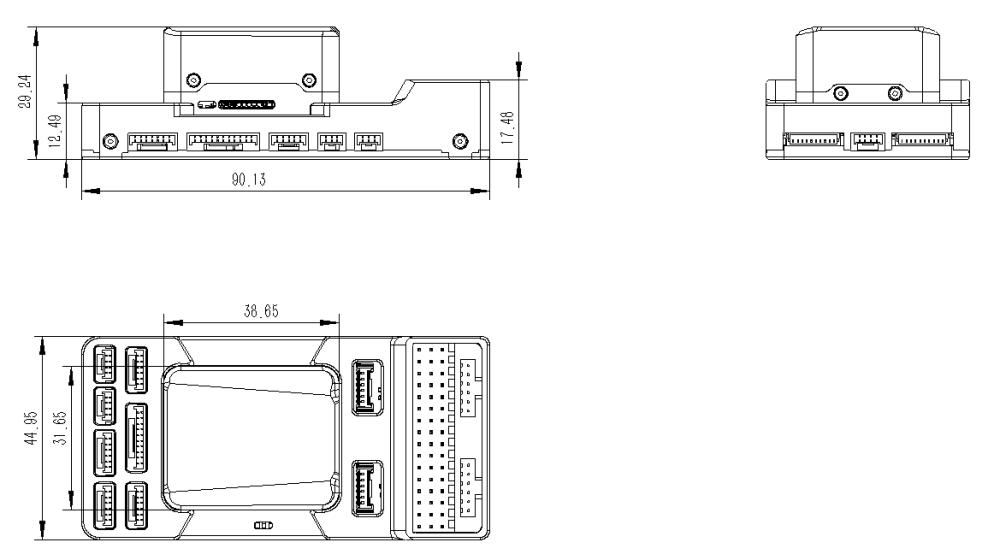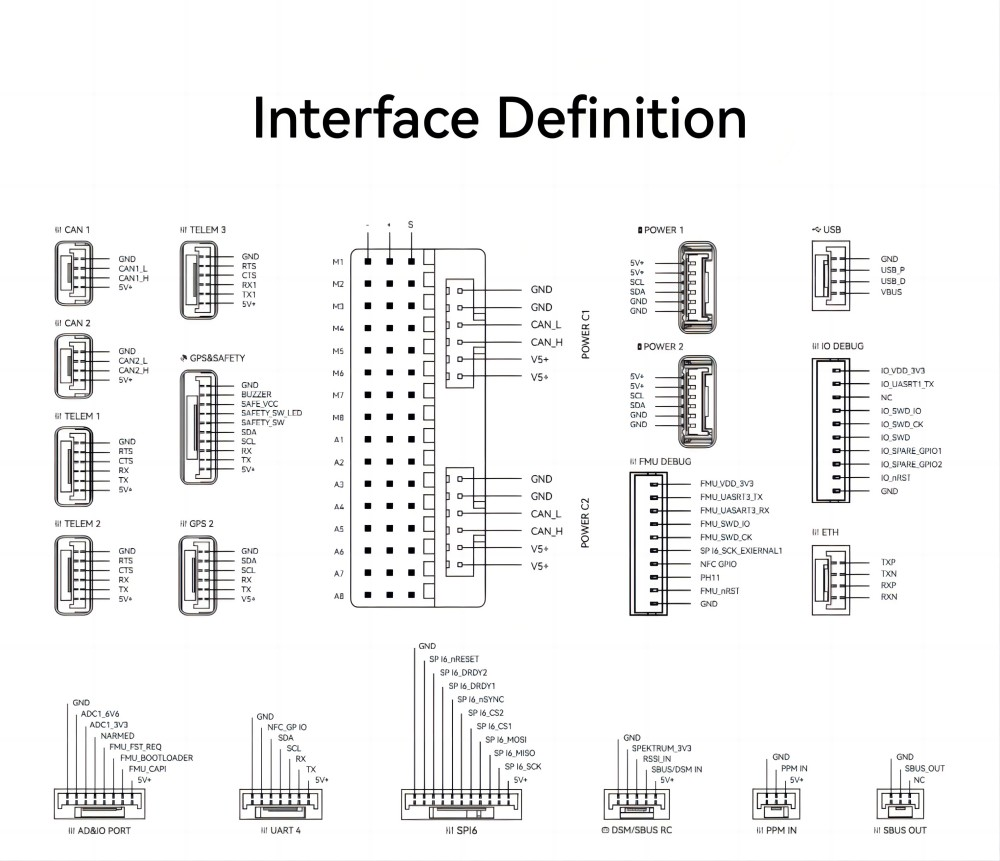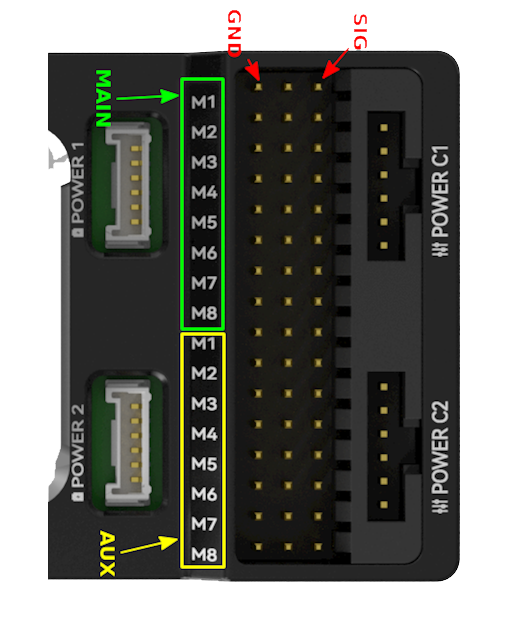Featuring STM32H7 cpu, vibration isolation of IMUs, redundant IMUs, double redundant barometers, IMU heating, and integrated Ethernet for high speed connections to companion computers.
- Power
- Dual SMBUS/I2C Power Module Inputs
- CAN Power Module included with autopilot
- Interfaces
- 8x UARTS, 6 Available for customer use
- 16x PWM outputs
- PPM/SBUS input, DSM/SBUS input
- SPI6 port
- 2x I2C ports for external compass, airspeed sensor, etc. on GPS connector
- USB port (with remote cabling), USB connector on module
- 2 x CAN port
- Buzzer and Safety Switch
- microSD card
- Ethernet
- Size and Dimensions
- Heat disipating aluminum case

Pinouts¶
UART Mapping
- SERIAL0 -> USB
- SERIAL1 -> UART7 (Telem1) RTS/CTS pins
- SERIAL2 -> UART5 (Telem2) RTS/CTS pins
- SERIAL3 -> USART1 (GPS1)
- SERIAL4 -> UART8 (GPS2)
- SERIAL5 -> USART2 (Telem3) RTS/CTS pins
- SERIAL6 -> UART4 (User)
- SERIAL7 -> USART3 (Debug)
- SERIAL8 -> USB Virtual(MAVLink, can be used for SLCAN with protocol change)
RC Input
The PPM pin, which by default is mapped to a timer input, can be used for all ArduPilot supported receiver protocols, except CRSF/ELRS and SRXL2 which require a true UART connection. However, FPort, when connected in this manner, will only provide RC without telemetry.
To allow CRSF and embedded telemetry available in Fport, CRSF, and SRXL2 receivers, a full UART, such as SERIAL6 (UART4) would need to be used for receiver connections. Below are setups using Serial6.
- SERIAL6_PROTOCOL should be set to “23”.
- FPort would require SERIAL6_OPTIONS be set to “15”.
- CRSF/ELRS would require SERIAL6_OPTIONS be set to “0”.
- SRXL2 would require SERIAL6_OPTIONS be set to “4” and connects only the TX pin.
Any UART can be used for RC system connections in ArduPilot also, and is compatible with all protocols except PPM.
PWM Output
The Pixhawkv6X supports up to 16 PWM outputs. All 16 outputs support all normal PWM output formats. All FMU outputs support DShot, except 7 and 8. These do not support serial LEDS either.
The 8 FMU PWM outputs are in 4 groups:
- Outputs 1, 2, 3 and 4 in group1
- Outputs 5 and 6 in group2
- Outputs 7 and 8 in group3
FMU outputs within the same group need to use the same output rate and protocol. If any output in a group uses DShot then all channels in that group need to use DShot.
Battery Monitoring
The autopilot defaults are setup for CAN Power Module use (normally supplied with autopilot):
- BATT_MONITOR = 8
- CAN_P1_DRIVER = 1
- CAN_P2_DRIVER = 1
- CAN_D1_PROTOCOL = 1
- CAN_D2_PROTOCOL = 1
However, the board also has 2 dedicated power monitor ports with a 6 pin connectors. These are intended for use with the I2C power monitors, if desired.
Note
do not try to use the Mission Planner SETUP->Optional Hardware->Battery Monitor tab to setup the I2C power monitors for the Pixhawk6X. The parameters needed for their operation are already setup by default:
- BATT_MONITOR = 21
- BATT_I2C_BUS = 1
- BATT_I2C_ADDR = 65
Compass
The Pixhawkv6X has a built-in compass. Due to potential interference, the autopilot is usually used with an external I2C compass as part of a GPS/Compass combination.
GPIOs
The 8 FMU outputs can be used as GPIOs (relays, buttons, RPM etc). To use them you need to set the output’s SERVOx_FUNCTION to -1.
The numbering of the GPIOs for PIN variables in ArduPilot is:
- PWM1 50
- PWM2 51
- PWM3 52
- PWM4 53
- PWM5 54
- PWM6 55
- PWM7 56
- PWM8 57
Additional GPIOs:
- FMU_CAP1 58
- NFC_GPIO 59
Analog inputs
The Pixhawkv6X has 2 analog inputs, one 6V tolerant and one 3.3V tolerant
- ADC Pin12 -> ADC 6.6V Sense
- ADC Pin13 -> ADC 3.3V Sense
- Analog 3.3V RSSI input pin = 103
Connectors
Unless noted otherwise all connectors are JST GH
Loading Firmware
The board comes pre-installed with an ArduPilot compatible bootloader, allowing the loading of xxxxxx.apj firmware files with any ArduPilot compatible ground station.
Bi-Directional DShot firmware variations are available also providing BDShot capability on outputs 1-6.


























Reviews
There are no reviews yet.